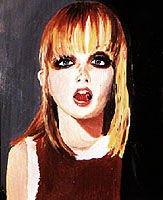View current page
...more recent posts

Karen Kilimnik: So much better than Elizabeth Peyton it's not even funny
Here are some quotes from a silly New York Times article today about the disparity in auction prices between male and female artists (thanks again, Bill):
One more example. Since three emerging figurative painters - Luc Tuymans of Belgium and the Americans John Currin and Elizabeth Peyton - were exhibited together at the Museum of Modern Art in 1997, they, too, have come to seem almost like classmates, all heralded as leading figures in painting's contemporary resurgence. [What resurgence? Painting left the art market for about two years in the mid-70s, it hasn't gone away since.] The two men's canvases have sold for more than $1 million. Meanwhile, Ms. Peyton's 1996 oil portrait of a languorous John Lennon is estimated by Christie's at $200,000 to $300,000. And even that is a lot more than the current record price for her work: $136,000, set in June 2002.This is great news. Perhaps there is a (benign, de-gendered) God, after all. Peyton's work is tepid and blandly illustrational: rather than languorous the paintings would be better described as fey, or wan, and that's all she does, fey and wan, over and over and over. Stupid looking people all with the same cherry red lips--how about some other colors for those? Karen Kilimnik's good bad paintings ca. 1997 would have been a better choice for that particular (overrated) MOMA show.
Art defies head-on comparison. Forget apples and oranges; how does one judge the value of [Rachel] Whiteread's cast fiberglass and rubber mattress relative to Mr. Hirst's deteriorating shark? Or of Maurizio Cattelan's sculpture of a taxidermied ostrich compared with [Agnes] Martin's canvas with the faintest of graphite grids on it? The contemporary art market has at least one frustratingly simple answer: price. And from that perspective, the comparison is unmistakable: art made by women is regarded less highly than art made by men.This argument is tautological: the art world chooses men over women in the competition for higher prices; choices can't be easily made; the only criteria for choosing is price. Art doesn't actually "defy comparison," people do it all the time, and usually not as ludicrously as above. You compare artist to artist, rather than arbitrarily chosen artwork to arbitrarily chosen artwork.
In all of the following comparisons (originally posed in the article), the former artist is protean, energetic, and innovative and the latter is refined, narrow-ranged, building on and deepening existing ideas, and sorry, we tend to value one more than the other: Philip Guston vs Joan Mitchell, Damien Hirst vs Rachel Whiteread, and (if you must compare these two) Mauricio Catellan vs Agnes Martin. Guerrilla Girl repellent: "Women can make art as well as men can. Many of the artists mentioned in the article are undervalued and the market will eventually correct for that, but on the basis of scholarship and consensus, not nitwitty New York Times articles that refuse to make meaningful comparisons."

Lucas Samaras' Hands, animated GIF, 2005
Made it to the last night of Bent 2005, the circuit bending festival, at the Tank, located on a "soon-to-be-bulldozed part of far West 42nd Street," as the Washington Post describes it. Downstairs people were sitting at benches with soldering guns disassembling toys and appliances, rewiring them to make interesting electro-gnarly sounds; upstairs people were performing using such instruments. The Post article about the festival is here; an excerpt discussing a previous night's performances gives you the flavor:
None of these people is playing songs, in the sense that a song has a chorus and lyrics, a beginning, middle and end. For the most part, the performers just make noise for about 10 minutes, then the noise subsides and when they say "thank you," you know the song is over. The pleasure for performer and fan alike comes from the textures of the noise, the idea of it as a landscape that has never been experienced before. It's all about sonic novelty. You get the sense, too, that these circuit benders just like to freak people out. T-Bone, for example, wears braids, which give her the look of a schoolgirl, until you notice the top of her head, which is shaved and vividly tattooed, like a Technicolor yarmulke. One can only think of her parents.Note to the WaPo writer: Dude, you're obviously interested in this subject or you wouldn't have spent the time writing and researching it to the degree you did; you definitely took it beyond a "mere assignment." So why the condescending tone throughout your article? Is it to satisy your editors? Are you reaching out to some perceived middlebrow reading audience that you feel wouldn't like this music and that you have to apologize in advance to? Get a blog, you can be more honest. (And I can't believe you called Texas Instruments to ask the PR person if the company knew Speak and Spells were being bent. What a journo-nerd. And the performers don't generally say "Thank you," they just stop. )
Back to the festival. At 5:00 pm Paul B. Davis of BEIGE/8-Bit Construction Set gave a Nintendo-hacking workshop. In contrast to fellow BEIGE-r Cory Arcangel's lectures on this subject, which are generally laff riots, Davis's was calm and droll, but similarly informative and persuasive on the hacking principals underlying the dismantling of silly games from people's youths. He makes a distinction between general purpose computers (like the one you're reading this on) and special purpose ones (like a pocket calculator) and points out that the old game cartridges are the former, and thus can do the same kinds, or categories, of things a sleek laptop can do--it's just a matter of accessing and reprogramming them. Opening up a Nintendo cartridge and burning new data to it is a way to gain access to a device brimming with art and music making potential, albeit on the low res end of the spectrum. The age or nostalgic appeal of the machinery is interesting but largely irrelevant.
Davis came back around midnight and did a DJ set interspersed with surprisingly substantial ringtones played on his Ericsson phone through the Tank PA. Cellular audio has noticeably improved from the early bleepy stage--if improved is really the right word considering most of the material is still cheesy pop songs. The vinyl set featured electro, Grime (a successor to 2-step garage in the London club scene), and Funk Carioca, which is new to me but quite amazing. Here's a description I found googling:
Funk Carioca (Rio funk) is the product of Brazil's favelas parties and fuels the night-long bailes that form the nocturnal soundtrack of Rio's hills. Funk Carioca combines street smarts with popping dirty electro beats and the intensity of DIY techno topped with some crude lyrical rhymes resulting in an irresistible cocktail that grabs you by the hips and never lets go.More on the Bent Festival, including photos, possibly, soon.
Edited slightly for coherency, accuracy, tact, etc.
